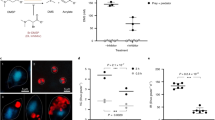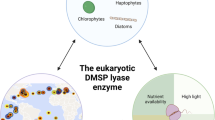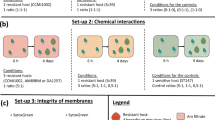Abstract
Parasitoids are a major top-down cause of mortality of coastal harmful algae, but the mechanisms and strategies they have evolved to efficiently infect ephemeral blooms are largely unknown. Here, we show that the generalist dinoflagellate parasitoid Parvilucifera sinerae (Perkinsozoa, Alveolata) is activated from dormancy, not only by Alexandrium minutum cells but also by culture filtrates. We unequivocally identified the algal metabolite dimethylsulphide (DMS) as the density-dependent cue of the presence of potential host. This allows the parasitoid to alternate between a sporangium-hosted dormant stage and a chemically-activated, free-living virulent stage. DMS-rich exudates of resistant dinoflagellates also induced parasitoid activation, which we interpret as an example of coevolutionary arms race between parasitoid and host. These results further expand the involvement of dimethylated sulphur compounds in marine chemical ecology, where they have been described as foraging cues and chemoattractants for mammals, turtles, birds, fish, invertebrates and plankton microbes.
Similar content being viewed by others
Log in or create a free account to read this content
Gain free access to this article, as well as selected content from this journal and more on nature.com
or
References
Anderson DM . (2009). Approaches to monitoring, control and management of harmful algal blooms (HABs). Ocean Coast Manage 52: 342–347.
Berdalet E, Llaveria G, Simó R . (2011). Modulation of dimethylsulfoniopropionate (DMSP) concentration in an Alexandrium minutum (Dinophyceae) culture by small-scale turbulence: a link to toxin production? Harmful Algae 11: 88–95.
Caruana AMN, Steinke M, Turner SM, Malin G . (2012). Concentrations of dimethylsulphoniopropionate and activities of dimethylsulphide-producing enzymes in batch cultures of nine dinoflagellate species. Biogeochemistry 110: 87–107.
Chambouvet A, Morin P, Marie D, Guillou L . (2008). Control of toxic marine dinoflagellate blooms by serial parasitic killers. Science 322: 1254–1257.
Endres CS, Lohmann KJ . (2012). Perception of dimethyl sulfide (DMS) by loggerhead sea turtles: a posible mechanism for locating high-productivity oceanic regions for foraging. J Exp Biol 215: 3535–3538.
Garcés E, Alacid E, Bravo I, Figueroa R, Fraga S . (2012). Parvilucifera sinerae (Alveolata, myzozoa) is a generalist parasitoid of dinoflagellates. Protist doi:10.1016/j.protis.2012.11.004 (in press).
Heisler J, Gilbert PM, Burkholder JM, Anderson DM, Cochlan W, Dennison WC et al (2008). Eutrophication and harmful algal blooms: A scientific consensus. Harmful Algae 8: 3–13.
Ianora A, Bentley MG, Caldwell GS, Casotti R, Cembella AD, Engström-Öst J et al (2011). The relevance of marine chemical ecology to plankton and ecosystem function: an emerging field. Mar Drugs 9: 1625–1648.
Lana A, Bell TG, Simó R, Vallina SM, Ballabrera-Poy J, Kettle AJ et al (2011). An updated climatology of surface dimethlysulfide concentrations and emission fluxes in the global ocean. Global Biogeochem Cy 25: GB1004 doi:10.1029/2010GB003850.
Millennium Ecosystem Assessment (2005) Ecosystems and Human Well-being: Synthesis. Island Press: Washington DC.
Nevitt GA . (2011). The neuroecology of dimethyl sulfide: a global-climate regulator turned marine infochemical. Integr Comp Biol 51: 819–825.
Pinhassi J, Simó R, González JM, Vila M, Alonso-Sáez L, Kiene RP et al (2005). Dimethylsulfoniopropionate turnover is linked to the composition and dynamics of the bacterioplankton assemblage during a microcosm phytoplankton bloom. Appl Environ Microbiol 71: 7650–7660.
Pohnert G, Steinke M, Tollrian R . (2007). Chemical cues, defence metabolites and the shaping of pelagic interspecific interactions. Trends Ecol Evol 22: 198–203.
Seymour JR, Simó R, Ahmed T, Stocker R . (2010). Chemoattraction to dimethylsulfoniopropionate throughout the marine microbial food web. Science 329: 342–345.
Simó R . (2001). Production of atmospheric sulfur by oceanic plankton: biogeochemical, ecological and evolutionary links. Trends Ecol Evol 16: 287–294.
Smetacek V . (2001). A watery arms race. Nature 411: 745.
Stefels J, Steinke M, Turner S, Malin G, Belviso S . (2007). Environmental constraints on the production and removal of the climatically active gas dimethylsulphide (DMS) and implications for ecosystem modelling. Biogeochemistry 83: 245–275.
Sunda W, Kieber DJ, Kiene RP, Huntsman S . (2002). An antioxidant function for DMSP and DMS in marine algae. Nature 418: 317–319.
Taylor FJR . (1968). Parasitism of the toxin producing dinoflagellate Gonyaulax catenella by the endoparasitic dinoflagellate Amoebophrya ceratii. J Fish Res Bd Canada 25: 2241–2245.
Tillman U, Alpermann T, John U, Cembella A . (2008). Allelochemical interactions and short-term effects of the dinoflagellate Alexandrium on selected photoautotrophic and heterotrophic protists. Harmful Algae 7: 52–64.
van Alstyne KL . (2008). Ecological and physiological roles of dimethylsulfoniopropionate and its products in marine macroalgae. In: Amsler CD, (eds) Algal chemical ecology. Springer: Heidelberg, Berlin, pp 173–194.
Zingone A, Enevoldsen HO . (2000). The diversity of harmful algal blooms: a challenge for science and management. Ocean Coast Manage 43: 725–748.
Acknowledgements
Support was provided by the (former) Spanish Ministry of Science and Innovation through projects PARAL (to E.G.) and SUMMER (to R.S.). K.P. acknowledges a grant from Australian Endeavour Foundation (Australian Government). We thank Beatriz Garriz for the drawing of the infection cycle.
Author information
Authors and Affiliations
Corresponding authors
Additional information
Supplementary Information accompanies the paper on The ISME Journal website
Supplementary information
Rights and permissions
About this article
Cite this article
Garcés, E., Alacid, E., Reñé, A. et al. Host-released dimethylsulphide activates the dinoflagellate parasitoid Parvilucifera sinerae. ISME J 7, 1065–1068 (2013). https://doi.org/10.1038/ismej.2012.173
Received:
Revised:
Accepted:
Published:
Issue date:
DOI: https://doi.org/10.1038/ismej.2012.173
Keywords
This article is cited by
-
Algal blooms in the ocean: hot spots for chemically mediated microbial interactions
Nature Reviews Microbiology (2024)
-
Dinophyceae can use exudates as weapons against the parasite Amoebophrya sp. (Syndiniales)
ISME Communications (2021)
-
Dimethyl sulfide mediates microbial predator–prey interactions between zooplankton and algae in the ocean
Nature Microbiology (2021)
-
Dimethylated sulfur production in batch cultures of Southern Ocean phytoplankton
Biogeochemistry (2020)
-
A high-resolution time-depth view of dimethylsulphide cycling in the surface sea
Scientific Reports (2016)



